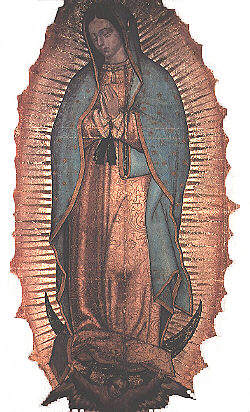|
Studies into the
reflections present in the eyes of the Virgin of Guadalupe have been
ongoing since as far back as 1948, and possibly earlier. There are reports
that in several studies on pictures of the eyes, ophthalmologists have even
identified micro artery circulation in the free edge of the image's
eyelids.
Science Stunned By 16thC Scene Found In
Virgin Of Guadalupe's Eyes
[Original headline: SCIENCE STUNNED BY
VIRGIN OF GUADALUPE'S EYES
Engineer Sees a Reflection, Literally, From a Scene in 1531]
 Rome-
Digital technology is giving new leads in understanding a phenomenon that
continues to puzzle science: the mysterious eyes of the image of Virgin of
Guadalupe. Rome-
Digital technology is giving new leads in understanding a phenomenon that
continues to puzzle science: the mysterious eyes of the image of Virgin of
Guadalupe.
The image, imprinted on the tilma of a
16th-century peasant, led millions of indigenous Indians in Mexico to
convert to the Catholic faith. Last week in Rome, results of research into
the famed image were discussed by engineer José Aste Tonsmann of the
Mexican Center of Guadalupan Studies during a conference at the Pontifical
Athenaeum Regina Apostolorum.
For over 20 years, this graduate of
environmental systems engineering of Cornell University has studied the
image of the Virgin left on the rough maguey fiber fabric of Juan
Diego’s tilma [cape G-fs]. What
intrigued Tonsmann the most were the eyes of the Virgin.
Though the dimensions are microscopic, the
iris and the pupils of the image’s eyes have imprinted on them a highly
detailed picture of at least 13 people, Tonsmann said. The same people are
present in both the left and right eyes, in different proportions, as
would happen when human eyes reflect the objects before them.
Tonsmann says he believes the reflection
transmitted by the eyes of the Virgin of Guadalupe is the scene on Dec. 9,
1531, during which Juan Diego showed his tilma, with the image, to Bishop
Juan de Zumárraga and others present in the room.
In his research, Tonsmann used a digital
process used by satellites and space probes in transmitting visual
information.
He insists that the image "that has
not been painted by human hand." As early as the 18th century,
scientists showed that it was impossible to paint such an image in a
fabric of that texture. The "ayate" fibers used by the Indians,
in fact, deteriorated after 20 years. Yet, the image and the fabric it is
imprinted on have lasted almost 470 years ago.
Tonsmann pointed out that Richard Kuhn, a
Nobel Prize winner in chemistry, has found that the image did not have
natural, animal or mineral colorings. Given that there were no synthetic
colorings in 1531, the image is inexplicable.
In 1979, Americans Philip Callahan and
Jody B. Smith studied the image with infrared rays and discovered to their
surprise that there was no trace of paint and that the fabric had not been
treated with any kind of technique.
"[How] it is possible to explain this
image and its consistency in time without colors, on a fabric that has not
been treated?" Tonsmann asked. "[How] is it possible that,
despite the fact there is no paint, the colors maintain their luminosity
and brilliance?"
Tonsmann, a Peruvian engineer, added,
"Callahan and Smith showed how the image changes in color slightly
according to the angle of viewing, a phenomenon that is known by the word
iridescence, a technique that cannot be reproduced with human hands."
The scientist began his study in 1979. He
magnified the iris of the Virgin’s eyes 2,500 times and, through
mathematical and optical procedures, was able to identify all the people
imprinted in the eyes.
The eyes reflect the witnesses of the
Guadalupan miracle, the moment Juan Diego unfurled his tilma before the
bishop, according to Tonsmann. In other words, the Virgin’s eyes have
the reflection that would have been imprinted in the eyes of any person in
her position. In the eyes, Tonsmann believes, it is possible to discern a
seated Indian, who is looking up to the heavens; the profile of a balding,
elderly man with a white beard, much like the portrait of Bishop Zumárraga,
painted by Miguel Cabrera, to depict the miracle; and a younger man, in
all probability interpreter Juan González.
Also present, Tonsmann believes, is an
Indian, likely Juan Diego, of striking features, with a beard and
mustache, who unfolds his own tilma before the bishop; a woman of dark
complexion, possibly a Negro slave who was in the bishop’s service; and
a man with Spanish features who looks on pensively, stroking his beard
with his hand.
In a word, the Virgin’s eyes bear a kind
of instant picture of what occurred at the moment the image was unveiled
in front of the bishop, Tonsmann says.
Moreover, in the center of the pupils, on
a much more reduced scale, another scene can be perceived, independent of
the first, the scientist contends. It is that of an Indian family made up
of a woman, a man and several children. In the right eye, other people who
are standing appear behind the woman.
Tonsmann ventured to express why he
believes the Virgin’s eyes have a "hidden" message for modern
times, when technology is able to discover it. "This could be the
case of the picture of the family in the center of the Virgin’s
eye," he says, "at a time when the family is under serious
attack in our modern world."
• Story originally published in •
Zenit News Agency - January 15 2001
|
 ¡En español!
¡En español!
 ¡En español!
¡En español!